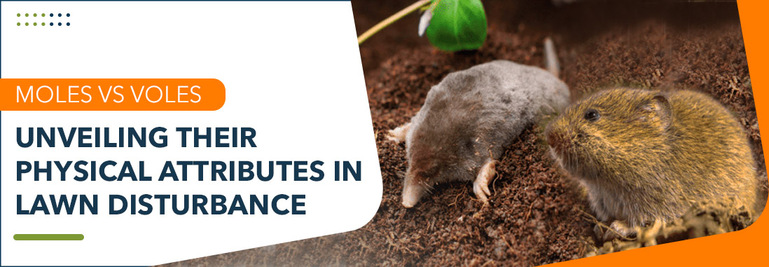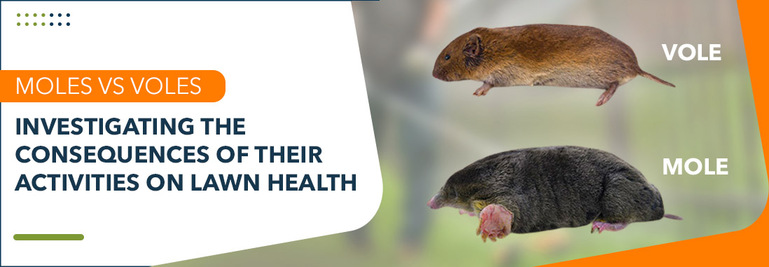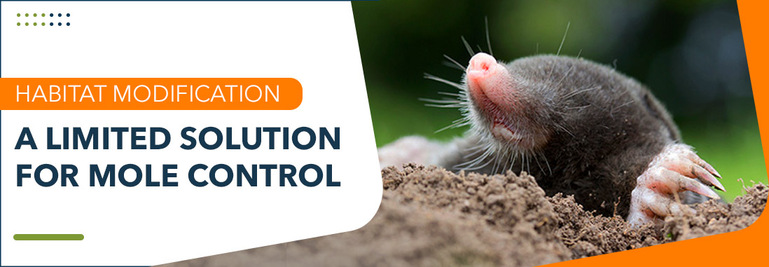Moles Vs Voles:
Revealing The Truth About Two Lawn Invaders Moles versus voles — what sets them apart? Homeowners looking to reclaim their lawn from an invader must correctly identify which animal is causing the damage to eliminate or remove it.
Moles versus voles — what sets them apart? Homeowners looking to reclaim their lawn from an invader must correctly identify which animal is causing the damage to eliminate or remove it.
Moles and voles may seem identical. They're both burrowers and garden pests. However, the differences in classification, behaviors, and anatomy make these animals quite different.
In this guide, we'll compare and contrast some of the following about moles and voles:
|
|
|
|
Moles versus voles: their physical characteristics
The physical qualities of moles set them apart. They're unique. Moles thrive underground. Although it's commonly believed moles have poor eyesight due to their limited exposure to light, new research shows the fascinating capabilities of these creatures. 
Scientists found that a mole's eyes are better than expected and can see light even when permanently shut. Though this does not change the fact that moles are short-sighted, it means there is much to be discovered about the capabilities of these subterranean animals.
Dr. Martin Collinson from the University of Aberdeen elaborated on the findings:
"In the case of the Iberian mole, we found that even though their eyes are permanently shut, they can see and run away from bright light, which we assume means they use their eyes to detect holes in the roof of their tunnel networks."
All this to say, moles are not blind. Nor are they nocturnal.
Some of the following features set moles apart:
Clawed forefeet help them dig
Long, pointed snouts allow them to locate food better
In comparison, voles look more like mice. The average vole measures up to five inches long, while the typical mouse is three inches long. Voles are more plump than mice, too. They have short snouts, and their eyes are easily identifiable compared to a mole's.
Voles, like mice, are small rodents. Moles are not. They are insectivores. Voles don't have the powerful digging capabilities of moles.
A mole's forefeet looks like oversized paddles. They turn slightly outward. They move dirt with ease. A vole's forefeet are tiny, agile claws that allow them to grasp and eat flower stems and small blades of grass.
Comparing the damage moles and voles cause to lawns
To better understand the damage moles and voles cause to lawns, it's important to learn about their dietary needs, behaviors, and reproductive norms.
Moles create raised tunnels in lawns. The damage they cause is usually quite extensive. Given good soil conditions, a single mole can tunnel up to 18 feet per hour. Since moles live exclusively underground and primarily search for earthworms to eat, they'll inevitably harm a lawn's surface.
A mole's digging negatively impacts the look of a yard. That's for sure. But a mole's activities also harm plants and grassroots, often providing an unstable lawn surface — an environment where weeds can thrive.
Moles can also cause damage to sprinkler heads and underground water lines. Moles don't, however, eat plants. Voles do. 
Voles are herbivores. They forage above ground. Here is what the UMass Extension Turf Program says about the damage caused to lawns by voles:
"Turf damage (by voles) is primarily caused by feeding, in which the voles chew the plants down to the crown (growing point) at ground level. Additional damage is caused by wear from vole 'traffic', and also from the accumulation of vole excrement along the runways. Folks are often blissfully unaware of the activity occurring beneath the snow, until damage becomes apparent upon snow melt in March or April."
Different voles cause different damage as well. There are 23 species of voles in the United States. Pine voles, for example, use tunnels more than meadow voles that live mostly aboveground. Pine voles prefer loamy soils. What do they eat? Their diet consists of tubers, bulbs, bark — even root bark — and seeds. And they eat a ton. They're also active year-round.
Meadow voles create small tunnels in grassy vegetation. In winter, they munch on tree bark. In the growing season, they go after the grass. Voles feed on many plant species. Gardens tempt them.
Give a vole an orchard, and he'll go wild. Same for tree planting and ornamentals. Voles prove quite the pest. Here are a few of the crops they'll go after:
|
|
|
|
|
Voles eat the crops; their tunnels destroy them, too. In The Handbook: Prevention and Control of Wildlife Damage, O'Brien notes that a voles runway systems "interfere with crop irrigation by displacing water and causing levees and checks to wash out. Voles also can ruin lawns, golf courses, and ground covers. Girdling (removing tree bark) and gnaw marks alone do not necessarily indicate the presence of voles, since other animals, such as rabbits, may cause similar damage. Vole girdling can be differentiated from girdling by other animals by the non-uniform gnaw marks."
One of the main things to consider with voles is that a single burrow system may contain several adults and their little ones. Vole reproduction rates can also cause an issue. They generally have one to five litters per year, with litter sizes averaging three to six babies.
In contrast, moles lead solitary lives. They rarely overlap territories with other moles outside of breeding season.
Catching one mole is usually all that's needed until another moves in. With voles, one may be the tip of the iceberg.
What differences are there in trapping moles and voles?
Preventing moles and voles requires different approaches. As a mole goes after earthworms and a few other subterranean creatures, the damage they cause can be quite extensive. As we mentioned before, a mole's ability to tunnel extensively, given the right conditions, is incredibly troublesome.
Remember: a vole is a rodent, but a mole is not.
Mole control should aim for damage mitigation. The two best ways to eliminate moles are to remove them physically or find a bait they are attracted to. Unfortunately, many baits for rodents falsely claim they work on moles as well.
Vole management might include habitat modification, such as clearing excessive vegetation near lawns and fences to protect plants from damage.
Let's take a further look at each control type and see what works best for moles and voles:
Exclusion
Exclusion is one of the best ways to protect trees and ornamental plants from voles and other animals like deer, mice, and rabbits.
Chicken wire won't cut it. Voles can slip through the holes. A quarter-inch, mesh-size metal hardware cloth that stands between two to three feet tall is ideal.
Exclusion is much more difficult with moles. A mole can tunnel down 40 inches. A physical barrier such as a fence or mesh may work, but it's not guaranteed to keep a mole out of a yard.
The cost and physical labor needed to place an underground fence or mesh is quite high — especially depending on the size of the area that needs protecting.
Exclusion is only a viable option for moles in small areas.
Traps
Traps are one of the most effective ways to remove a mole. In a survey of 215 homeowners, we found that the Gopher Hawk trap was the most preferred way to eliminate a mole.
On the other hand, voles often have too dense a population for traps to be effective. If the group size is small enough, traps will do the job. Most likely, traps will play a role in managing a vole problem, but they won't be the only method. In many cases, it's simply too costly and time-consuming to trap every vole present.
Habitat Modification
Habitat modification does not work well on moles. Many believe using insecticides effectively eliminates moles because they deplete their food sources. One popular myth says that to get rid of moles, one must eliminate grubs.
Purdue University Extension's Plant and Pest Diagnostic Lab noted, "While (moles) do eat grubs, it's an old wives tale that grubs are the reason that moles are in a lawn. Therefore, using grub control products as a method of controlling moles will not be effective. Even in grub free lawns, moles continue to survive, because the majority of their diet consists of the ever-present earthworm."
Attempting to eliminate the insects moles feed on is a dangerous game. While some critters are pests, some are vital to a lawn's health. It's a delicate ecosystem. Earthworms help keep lawns healthy and indicate a vibrant, well-functioning turf grass system.
For voles, habitat modification is a good choice. They're stealthy.
Voles depend on cover. Keeping weeds, litter, and ground cover in check is one of the best ways to keep voles at bay. Also, mulching practices make a difference. Keep mulch three feet or more away from the bases of trees to eliminate providing voles a safe spot to hide and eat. Here are a few other habitat modification tips to help with a vole problem:
Mow. Mow. Mow. Homeowners with a vole problem who struggle to maintain their lawn routinely can seek help on the GreenPal app. Mowing helps keep ground cover down and discourages vole activity.
Tilling soil destroys a vole's runway burrow systems and reduces ground cover.
Always think: could a vole call this home? If the answer is yes, consider relocating things like wood, brush, and compost pikes away from garden beds and trees to discourage voles from moving in.
Repellents, Baits, and Fumigants
Professionals often dispute claims that repellents work for moles. While some products are registered for voles, their effectiveness lacks extensive research and may or may not keep voles at bay.
Baits, however, work for both voles and moles.
Consider that baits pose a risk to pets and other animals. Follow all instruction guides or hire a professional to administer baits.
Fumigation is an ineffective method for moles and voles.
Quick Summary
Aspect | Details | |
Physical Characteristics | Moles have clawed forefeet, silky fur, and long snouts; voles resemble mice, with plump bodies and short snouts. | |
| Moles create tunnels and harm roots; voles feed on plants, causing wear from "traffic" and excrement accumulation. | |
Diet and Reproduction | Moles are insectivores and solitary; voles are herbivores, reproduce rapidly, and are active year-round. | |
Removal Methods | Exclusion and baits work for both pests; traps are effective for moles but may not suffice for dense vole populations. | |
Summary | Moles and voles differ in appearance, behavior, and damage to lawns. Effective control requires tailored methods considering diet, reproduction rates, and removal options. Knowing these differences is crucial for managing pests in lawns and gardens. |
Moles versus voles — they both play an important part in ecological systems, but they can also negatively impact the look and health of a lawn. Moles and voles are pretty different. Looks? Vastly different. Damage? Both cause extensive issues. Controlling moles and voles requires different approaches.
Knowing the difference between these creatures is critical for those who want to keep their lawn and garden pest-free. 



 Share
Share









